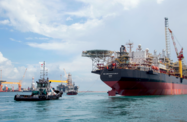The start of new gas production in Ghana has significantly improved the prospects for long-term growth in the country, although efforts to exploit domestic reserves for local power generation faced a minor setback earlier this year.
While Ghana’s hydrocarbons sector has seen relatively stable output over the first few months of 2016, a two-week period of inspection and maintenance work on the Kwame Nkrumah, a floating production, storage and offloading (FPSO) vessel, led to a temporary drop in gas supply to the power sector.
The shutdown slowed gas supply to the Volta River Authority’s (VRA) thermal generating facilities in Aboadze, reducing output by 250 MW, according to local media.
Expanding gas options
The FPSO has since re-started operations, but the extensive repairs highlight the importance of expanding access to feedstock for the country’s power plants.
Ghana currently has access to two sources of natural gas for its plants: domestic gas sourced from the Jubilee field with 577bn standard cu feet (scf) of recoverable reserves – which is processed by the recently commissioned Atuabo gas-processing plant, near Aboadze – and gas imported via the $1bn West African Gas Pipeline (WAGP), which originates in Nigeria, has an additional gas lateral at Tema and terminates at Takoradi.
Gas inflows from the 678-km WAGP have been unreliable and inconsistent at best, and for roughly 12 months between 2012 and 2013, supply was cut off completely due to pipeline damage by an errant ship anchor.
New domestic production
Associated gas from the Tweneboa-Enyenra-Ntomme (TEN) offshore field, which will also be processed at Atuabo, should help boost access to feedstock. First oil from TEN is expected in mid-2016, according to Tullow Oil, the field’s operator.
Next in line to reach production is the Sankofa-Gye Nyame oil and gas field, which is being developed by Eni and Vitol and where reserves are estimated at 1.5trn scf – enough to meet all of Ghana’s anticipated thermal electricity needs through to 2036. Production is expected from 2017, while processing is to be executed by both companies on an offshore vessel.
That gas, combined with Atuabo’s ability to reach a capacity of 150m scf per day, implies that Ghana should be able to significantly reduce fuel imports for electricity generation with its domestic supply.
LNG plans
However, this will not be enough to solve Ghana’s power needs, Ben Asante, gas advisor to the minister of petroleum, told local media in late April. As a result, another potential new source to address demand in the shorter term is liquefied natural gas (LNG), with a group of private investors exploring the potential for a combined-cycle plant fed by a floating storage and regasification unit.
In February the state-owned Ghana National Petroleum Corporation signed an agreement with energy infrastructure investment platform Quantum Power for the Tema LNG project, to be located 12 km offshore.
Upon completion later this year, the $500m plant, which is being developed using a build-own-operate-transfer structure, will have the capacity to receive, store, regasify and deliver around 3.4m tonnes of LNG per year, equivalent to approximately 500m scf of gas per day.
Renewable expansion plans
The recent maintenance work on the FPSO has highlighted the importance of the government’s efforts to further encourage diversification for Ghana’s energy needs. The VRA, for example, has committed to adding more renewable sources, particularly wind and solar, to its energy portfolio to meet future power demand.
In mid-April a new 20-MW solar plant, developed by Chinese technology firm Beijing Xiaocheng Company, came on-line in the country’s Central Region, about 20 km from Accra, and is expected to double its capacity by 2020.
This adds to the 2.5-MW Navrongo solar project, in operation since 2013, and the VRA’s efforts to develop a 12-MW solar project in the Upper West region.
These projects form part of a broader bid to achieve universal access to electricity by the end of the year and increase the share of renewable energy to 10% of output by 2020.
Oxford Business Group is now on Instagram. Follow us here for news and stunning imagery from the more than 30 markets we cover.

